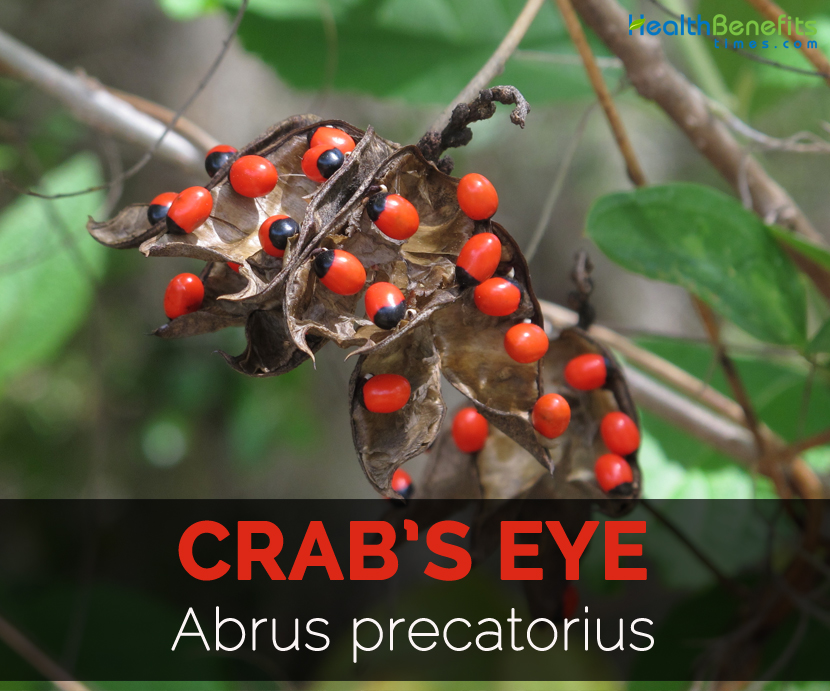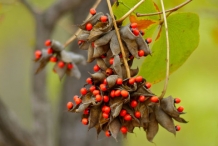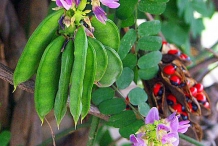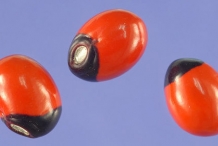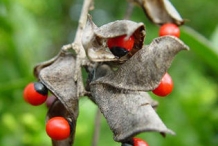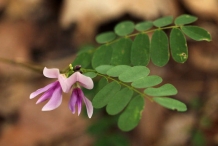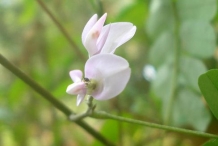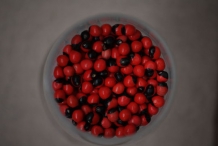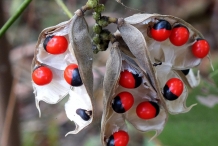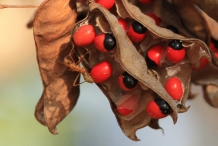White and Red are the two varieties of Crab’s eye. As the sizes of the seeds are uniform, it is used as standards weight measurement. The seeds are used as a treatment for headache, paralysis, dysentery, ulcer, nervous disorder and alopecia. It possess sexual stimulant, antitumor, antibacterial, antidiabetic and anti-inflammatory properties. In traditional medicine it is used to cure the wounds, sores and scratches made by mice, cats and dogs. When the seeds are injected, it is hundred times minor harmful in comparison to taken by mouth.
History
It is native to India and tropical Asia. It becomes invasive and weedy where it got introduced. It was used as an ornament and art object. The infusions are used in the folk medicine of Africa and South America to treat inflammations such as conjunctivitis. Medicinally it was used to accelerate labor, abortion and used as oral contraceptive. It is used in Chinese medicine to aid fever. In Ayurvedic medicine, roots and leaves are used to treat bronchitis, asthma and respiratory ailments.
Plant
The plant is annual woody, climber, branching and deciduous vine which grows upto 10 m long. Leaves are paripinnate, suboblong, 1-2 x 0.4-0.8 cm and pale green. The leaflets are oblong; 2.5 cm long and 1.5 cm wide. The stems are slender and branched. The small flowers are pink, lavender or white. The fruits are elliptic pods which is 4 cm long, dehiscent and turgid. The pods possess 3 to 8 seeds which are subglobose, scarlet-red and 6-7 mm (< 1 inch) long.
Traditional Health Benefits
Crab’s eye has poisonous seeds which are red in color but white seeds are also found. The other parts of the plant are used for various medicinal purposes. The leaf acts as an aid for body inflammation and wounds. The grinded seeds in rice water help to treat premature hair loss and skin imperfection.
- Leaves are used on gum for the mouth sores and to prepare the preparations of skin cancer.
- The tea made from leaves is a cure for colds, fevers and coughs.
- In Ayurveda, the plant is used to promote hair growth.
- It is also used as ingredient in the Indian hair product.
Afghanistan:
The dried seeds are used orally as aphrodisiac.
Brazil:
The root and dried leaves are used orally as a tonic for nerves.
Cambodia:
The extract made from hot water and seeds are used orally to treat malaria.
Central Africa:
- The chewing of root is an aid for snake bites.
- Central African tribes use seeds orally to treat the intestinal worms.
- The dose of 200 mg is helpful for thirteen menstrual cycles.
East Africa:
- The decoction made from aerial parts helps to treat gonorrhea.
- The juice of fresh leaves is an aid for stomach problems, bilharziasis and used as antiemetic.
- The powdered form of leaves is used in swellings and cuts.
- The leaf decoction is used for the chest pains.
- The steam of boiling leaves helps to cure inflamed eyes.
- The extract of dried seeds is used for eye infections.
Guam:
Men use the leaf pulp as aphrodisiac and women use it to ease childbirth.
Haiti:
Orally the leaf decoction is helps to treat flu and coughs.
India:
- The water extract made from dried roots and leaves is used for eye ailments.
- In Ayurvedic medicine, seeds are used as abortifacient.
- The decoction made from dried seeds helps to promote abortion.
Jamaica:
The decoction made from dried leaves as well as root boiled in milk is used as tonic.
Kenya:
The leaf juice is used as an aid for coughs.
Mozambique:
The hot water extract made from roots is used as an aphrodisiac.
Nepal:
Orally, seeds are used as aphrodisiac.
Nigeria:
The extract of fresh root is considered as antimalarial and anticonvulsant.
Pakistan:
The seeds are used for abortion.
Taiwan:
The dried root decoction is a cure for hepatitis and bronchitis.
Tanzania:
The decoction made from roots or leaf sap helps to treat asthma and used as aphrodisiac.
Thailand:
The crushed leaves with oil are poultice and used as anti-inflammatory.
Virgin Islands:
The dried root decoction is used to cure gonorrhea, bilharziasis, chest pains and tapeworms.
West Indies:
- The root is used to cure snake bites.
- Seeds are considered as emetic, purgative and anthelmintic.
Precautions
- The high dose of Crab’s eye causes vomiting and diarrhea, stomach cramps, tachycardia, cold sweats, coma and nausea.
- The powdered seeds (unpurified) if used on wounds provide toxic effects.
- The excessive use of roots causes vomiting.
- It should be avoided by pregnant or lactating women and children less than 5 years of age.
- The seeds possess abrin which is fatal to both children and adults.
- The long use results in anemia and raises the white blood cells.
- It might slow down the clotting of blood.
- It lowers the blood sugar.
- It increases the chances of bleeding so one should stop using it before two weeks of surgery.
- The contact with seed infusion damages eye, conjunctivitis and may result to blindness.
Purification method
The seeds of Crab’s eye should be tied in two layered cloth. Hang it in cow milk which is kept in a pot. Boil the milk with seeds hanging for about 3 hours (1 yama). It is known as Swedana. Then take out the seeds and wash it in hot water. Dry it and preserve. For this purpose the pot is used which is known as Dola Yantra. The fermented liquid could be used instead of milk.
References:
http://davesgarden.com/guides/pf/go/54030/
http://www.plantnames.unimelb.edu.au/Sorting/Abrus.html
http://easyayurveda.com/2015/09/12/rosary-pea-abrus-precatorius/
http://www.hear.org/pier/species/abrus_precatorius.htm
http://www.wikilengua.org/index.php/Plantaemundi:Abrus
https://www.ncbi.nlm.nih.gov/pmc/?term=Abrus+precatorius
file:///C:/Users/drchi_000/Downloads/article1381765518_Paul%20et%20al%20(3).pdf
file:///C:/Users/drchi_000/Downloads/9781588292810-c2%20(3).pdf
https://en.wikipedia.org/wiki/Abrus_precatorius
http://www.alwaysayurveda.com/abrus-precatorius/
https://www.health.qld.gov.au/poisonsinformationcentre/plants_fungi/crabseye.asp
http://www.iloveindia.com/indian-herbs/abrus-precatorius.html
Comments
comments
| Crab's eye Quick Facts | |
|---|---|
| Name: | Crab's eye |
| Scientific Name: | Abrus precatorius |
| Origin | It is native to India and tropical Asia. It becomes invasive and weedy where it got introduced. |
| Colors | Scarlet-red (Seeds) |
| Shapes | Subglobose, Thick: 3.5 mm; Length: 6-7 mm (< 1 inch) (Seeds) |
| More facts about Crab's eye | |
